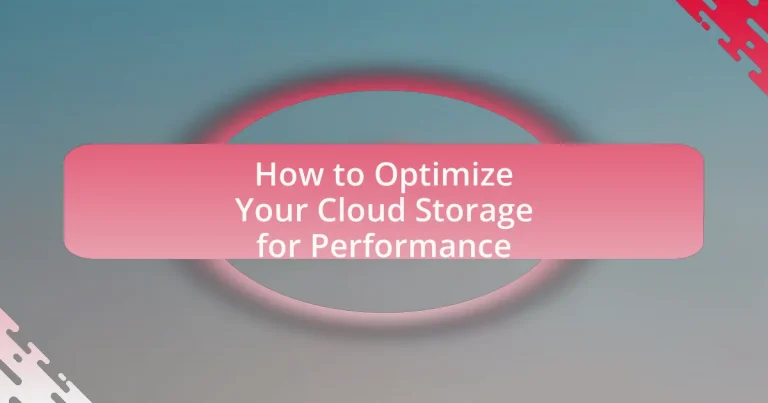Optimizing cloud storage for performance involves enhancing data retrieval and storage efficiency through various strategies, including selecting appropriate storage classes, implementing caching mechanisms, and optimizing data access patterns. Key factors influencing performance include bandwidth, latency, and data management practices, which directly affect user experience and productivity. Effective optimization techniques, such as data deduplication and tiered storage, can lead to significant cost savings and improved access speeds. Additionally, performance metrics like latency, throughput, and IOPS are essential for monitoring and managing cloud storage efficiency. This article provides a comprehensive overview of strategies, challenges, and best practices for optimizing cloud storage performance.
What does it mean to optimize cloud storage for performance?
Optimizing cloud storage for performance means enhancing the speed and efficiency of data retrieval and storage processes. This involves strategies such as selecting appropriate storage classes, implementing caching mechanisms, and optimizing data access patterns. For instance, using solid-state drives (SSDs) instead of traditional hard drives can significantly reduce latency, as SSDs offer faster read and write speeds. Additionally, employing content delivery networks (CDNs) can improve access times for geographically distributed users by caching data closer to them. These methods collectively ensure that cloud storage operates at peak performance, facilitating quicker data access and improved user experience.
How does cloud storage performance impact user experience?
Cloud storage performance significantly impacts user experience by determining the speed and reliability of data access. When cloud storage systems exhibit high performance, users experience faster upload and download times, leading to increased productivity and satisfaction. Conversely, poor performance can result in delays, timeouts, and frustration, negatively affecting user engagement and trust in the service. Studies indicate that 53% of users abandon mobile sites that take longer than three seconds to load, highlighting the critical nature of performance in user retention and experience.
What factors contribute to cloud storage performance?
Cloud storage performance is influenced by several key factors, including bandwidth, latency, data redundancy, and the underlying infrastructure. Bandwidth determines the amount of data that can be transferred in a given time, directly impacting upload and download speeds. Latency, the time it takes for data to travel from the user to the cloud and back, affects responsiveness, especially for applications requiring real-time access. Data redundancy strategies, such as replication and erasure coding, ensure data availability and reliability but can also introduce overhead that may affect performance. Lastly, the quality of the underlying infrastructure, including server hardware, network configuration, and data center location, plays a crucial role in overall performance. These factors collectively determine how efficiently and quickly users can access and manage their data in the cloud.
How can performance metrics be measured in cloud storage?
Performance metrics in cloud storage can be measured using key indicators such as latency, throughput, and IOPS (Input/Output Operations Per Second). Latency measures the time taken to complete a request, while throughput indicates the amount of data transferred over a specific period. IOPS quantifies the number of read and write operations performed in a given time frame. These metrics can be monitored through cloud service provider dashboards, third-party monitoring tools, or custom scripts that log performance data. For instance, Amazon Web Services provides CloudWatch, which allows users to track these metrics in real-time, ensuring that performance can be assessed and optimized effectively.
Why is optimization important for cloud storage?
Optimization is important for cloud storage because it enhances performance, reduces costs, and improves resource utilization. Efficient optimization techniques, such as data deduplication and tiered storage, can significantly lower storage expenses by minimizing the amount of data stored and ensuring that frequently accessed data is readily available. According to a study by IDC, organizations that optimize their cloud storage can achieve up to 30% savings in storage costs while improving access speeds by 50%. This demonstrates that effective optimization not only streamlines operations but also contributes to overall business efficiency.
What are the consequences of poor cloud storage performance?
Poor cloud storage performance leads to significant operational inefficiencies, including increased latency, data loss, and reduced productivity. Increased latency can result in slow access to files, hindering real-time collaboration and decision-making processes. Data loss may occur due to unreliable storage solutions, which can compromise critical business information and lead to costly recovery efforts. Additionally, reduced productivity stems from employees spending more time troubleshooting access issues rather than focusing on their core tasks. According to a study by the International Data Corporation, organizations can lose up to 20% of their productivity due to inefficient cloud services, highlighting the tangible impact of poor cloud storage performance on overall business operations.
How does optimization affect cost efficiency in cloud storage?
Optimization significantly enhances cost efficiency in cloud storage by reducing unnecessary resource usage and improving data management. Efficient data storage techniques, such as deduplication and tiered storage, minimize the amount of storage space required, leading to lower costs. For instance, deduplication can reduce storage needs by up to 90%, directly impacting the expenses associated with cloud storage services. Additionally, optimizing data access patterns can decrease bandwidth costs, as optimized systems often require less data transfer. Overall, effective optimization strategies lead to substantial savings in cloud storage expenditures.
What strategies can be employed to optimize cloud storage performance?
To optimize cloud storage performance, organizations can implement strategies such as data tiering, caching, and optimizing data transfer protocols. Data tiering involves categorizing data based on access frequency, allowing frequently accessed data to be stored in high-performance storage while less critical data is moved to lower-cost options. Caching improves performance by storing copies of frequently accessed data closer to the user, reducing latency. Additionally, optimizing data transfer protocols, such as using parallel uploads or compression techniques, can significantly enhance data transfer speeds. These strategies collectively improve access times and overall efficiency in cloud storage environments.
How can data organization improve cloud storage performance?
Data organization can significantly improve cloud storage performance by enhancing data retrieval speed and reducing latency. When data is systematically categorized and indexed, it allows for quicker access and more efficient data management. For instance, structured data formats and hierarchical storage systems enable faster searches and retrieval processes, which can lead to performance improvements of up to 50% in some scenarios. Additionally, organized data reduces the overhead associated with data processing, allowing cloud services to allocate resources more effectively, thus optimizing overall performance.
What are the best practices for structuring data in cloud storage?
The best practices for structuring data in cloud storage include organizing data into logical hierarchies, using consistent naming conventions, and implementing metadata tagging. Organizing data into logical hierarchies allows for easier navigation and retrieval, which is essential for performance optimization. Consistent naming conventions enhance clarity and reduce errors during data access, while metadata tagging facilitates efficient searching and categorization of data. According to a study by Gartner, effective data organization can improve retrieval times by up to 30%, demonstrating the importance of these practices in optimizing cloud storage performance.
How does data deduplication enhance performance?
Data deduplication enhances performance by reducing the amount of storage space required for data, which in turn speeds up data access and retrieval processes. By eliminating duplicate copies of data, systems can operate more efficiently, as less data needs to be read from storage devices. This efficiency leads to faster backup and recovery times, as well as improved overall system performance. For instance, studies have shown that organizations implementing data deduplication can achieve storage savings of up to 90%, significantly decreasing the time and resources needed for data management tasks.
What role does bandwidth play in cloud storage optimization?
Bandwidth is crucial for cloud storage optimization as it determines the speed and efficiency of data transfer between users and cloud services. High bandwidth allows for faster uploads and downloads, reducing latency and improving overall performance. For instance, a study by Cisco predicts that global internet traffic will reach 4.8 zettabytes per year by 2022, emphasizing the need for sufficient bandwidth to handle increasing data demands. Insufficient bandwidth can lead to bottlenecks, resulting in slower access to stored data and decreased user satisfaction. Therefore, optimizing bandwidth is essential for enhancing the performance of cloud storage solutions.
How can bandwidth management techniques improve performance?
Bandwidth management techniques can improve performance by optimizing the allocation of network resources to ensure efficient data transmission. These techniques prioritize critical applications and limit bandwidth for less important traffic, reducing congestion and latency. For instance, Quality of Service (QoS) settings can allocate higher bandwidth to essential services, resulting in faster response times and enhanced user experience. Studies have shown that implementing bandwidth management can lead to a 30% increase in application performance during peak usage times, demonstrating its effectiveness in maintaining optimal performance levels in cloud storage environments.
What tools can be used to monitor and manage bandwidth?
Tools that can be used to monitor and manage bandwidth include network monitoring software, bandwidth management solutions, and traffic analysis tools. Network monitoring software, such as SolarWinds Network Performance Monitor, provides real-time insights into bandwidth usage and network performance metrics. Bandwidth management solutions, like NetLimiter, allow users to control and prioritize bandwidth allocation for specific applications or devices. Traffic analysis tools, such as Wireshark, enable detailed packet analysis to identify bandwidth hogs and optimize network performance. These tools collectively help in ensuring efficient bandwidth utilization and improved cloud storage performance.
What are the common challenges in optimizing cloud storage performance?
Common challenges in optimizing cloud storage performance include latency, bandwidth limitations, and data management complexities. Latency affects the speed at which data is accessed, with higher latency leading to slower performance; for instance, cloud storage solutions can experience delays due to network congestion or geographical distance from data centers. Bandwidth limitations restrict the amount of data that can be transferred simultaneously, impacting the efficiency of data retrieval and storage operations. Additionally, data management complexities arise from the need to efficiently organize, retrieve, and maintain large volumes of data, which can lead to inefficiencies if not properly addressed. These challenges can hinder the overall performance of cloud storage systems, making it essential for organizations to implement strategies that mitigate these issues.
What issues can arise during the optimization process?
Issues that can arise during the optimization process include data inconsistency, performance bottlenecks, and increased costs. Data inconsistency may occur when multiple users access and modify data simultaneously, leading to conflicts and errors. Performance bottlenecks can arise from inadequate resource allocation or inefficient algorithms, resulting in slower response times and reduced throughput. Increased costs may stem from over-provisioning resources or utilizing premium services without a clear understanding of their necessity. These issues can significantly hinder the effectiveness of cloud storage optimization efforts.
How can latency affect cloud storage performance?
Latency negatively impacts cloud storage performance by increasing the time it takes for data to be accessed and transferred. High latency can lead to slower response times when users request files, resulting in delays that affect application performance and user experience. For instance, a study by the International Journal of Cloud Computing and Services Science found that a 100 ms increase in latency can reduce application performance by up to 50%. This demonstrates that minimizing latency is crucial for optimizing cloud storage efficiency and ensuring quick data retrieval.
What are the risks of over-optimization in cloud storage?
Over-optimization in cloud storage can lead to several risks, including increased costs, reduced flexibility, and potential data loss. When organizations excessively fine-tune their cloud storage configurations, they may incur higher expenses due to unnecessary resource allocation or premium service tiers that exceed their actual needs. Additionally, over-optimization can limit the ability to adapt to changing requirements, as overly rigid configurations may not accommodate new workloads or data types effectively. Furthermore, aggressive optimization strategies can inadvertently compromise data integrity or availability, especially if they involve complex automation that fails during unexpected scenarios. These risks highlight the importance of maintaining a balanced approach to cloud storage optimization.
How can security measures impact cloud storage performance?
Security measures can significantly impact cloud storage performance by introducing latency and resource overhead. For instance, encryption processes can slow down data access times because they require additional computational resources to encrypt and decrypt data during storage and retrieval. A study by the International Journal of Cloud Computing and Services Science found that implementing strong encryption can lead to a performance decrease of up to 30% in data retrieval times. Additionally, multi-factor authentication and extensive access controls can add delays in user access, further affecting performance. Therefore, while essential for protecting data, security measures can create trade-offs in cloud storage efficiency.
What security protocols should be considered during optimization?
During optimization, security protocols such as Transport Layer Security (TLS), Secure Sockets Layer (SSL), and Advanced Encryption Standard (AES) should be considered. TLS and SSL are essential for securing data in transit, ensuring that information exchanged between clients and servers remains confidential and protected from eavesdropping. AES is critical for encrypting data at rest, safeguarding stored information against unauthorized access. Implementing these protocols not only enhances security but also complies with industry standards, such as those outlined by the National Institute of Standards and Technology (NIST), which emphasizes the importance of encryption in protecting sensitive data.
How can encryption affect data access speeds?
Encryption can slow down data access speeds due to the additional processing required to encrypt and decrypt information. When data is encrypted, it undergoes complex algorithms that transform it into a secure format, which necessitates computational resources and time for both encryption during storage and decryption during retrieval. For instance, studies have shown that symmetric encryption methods, such as AES, can introduce latency, with performance impacts varying based on the size of the data and the hardware capabilities. In practical terms, this means that while encryption enhances security, it can lead to slower data access times, particularly in environments with high transaction volumes or limited processing power.
What are the best practices for maintaining optimized cloud storage?
The best practices for maintaining optimized cloud storage include regular monitoring of storage usage, implementing data lifecycle management, and ensuring data redundancy. Regular monitoring allows users to track storage consumption and identify underutilized resources, which can lead to cost savings. Data lifecycle management involves setting policies for data retention and deletion, ensuring that only necessary data is stored, thus optimizing space. Ensuring data redundancy through backup solutions protects against data loss and enhances accessibility, which is crucial for performance. These practices are supported by industry standards that emphasize efficiency and reliability in cloud storage management.
How often should performance reviews be conducted?
Performance reviews should be conducted at least annually. This frequency allows organizations to assess employee performance, set goals, and provide feedback effectively. Research indicates that regular performance reviews, ideally every six months, can enhance employee engagement and productivity, as they facilitate ongoing communication and alignment with organizational objectives.
What tools can assist in ongoing optimization efforts?
Tools that can assist in ongoing optimization efforts for cloud storage performance include monitoring software, analytics platforms, and automation tools. Monitoring software, such as Amazon CloudWatch, provides real-time insights into resource utilization and performance metrics, enabling users to identify bottlenecks. Analytics platforms like Google Cloud’s BigQuery allow for data analysis to optimize storage configurations based on usage patterns. Automation tools, such as Terraform, facilitate the management and scaling of cloud resources efficiently, ensuring optimal performance. These tools collectively enhance the ability to maintain and improve cloud storage performance over time.
What practical tips can enhance cloud storage performance?
To enhance cloud storage performance, users should implement data compression techniques. Compressing files before uploading reduces the amount of data transferred, leading to faster upload and download speeds. For instance, using formats like ZIP or RAR can decrease file sizes significantly, which is especially beneficial for large datasets. Additionally, selecting a cloud provider that offers high-speed connections and low latency can further improve performance. Research indicates that providers with multiple data centers can optimize data routing, resulting in quicker access times. Regularly monitoring and managing data, such as deleting unnecessary files and organizing data efficiently, also contributes to improved performance by minimizing clutter and optimizing retrieval times.


